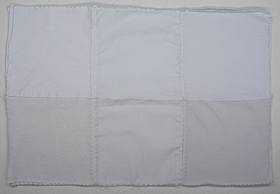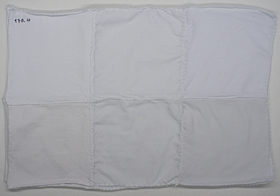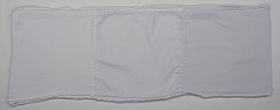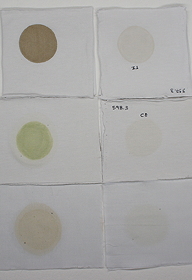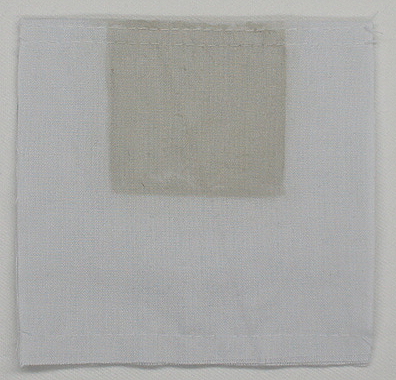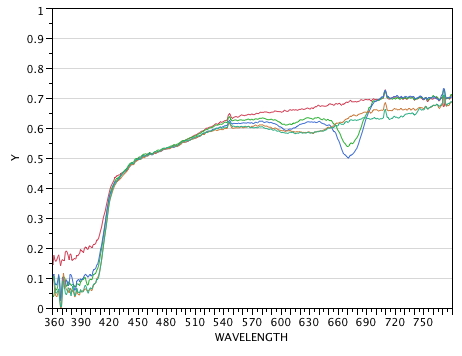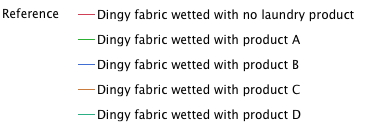 |
Conduct
Physical Experiments
|
|||||||||||||||||||||||||||||||||||||||||||||||||||||||
| |
The in-vitro dingy and double dingy monitors are test fabrics models fabricated on commercial fabrics, used by detergency labs as test monitors to be washed/dried according to actual laundry practices around the world.
|
|||||||||||||||||||||||||||||||||||||||||||||||||||||||
Dingy Monitors: |
||||||||||||||||||||||||||||||||||||||||||||||||||||||||
|
Example: Commercial machine washing process, following some specific Asian conditions, gentle cycle Before: wash 00
After: wash 15
|
Whiteness
Perception. Medium and
Long term. Code: DINGY_WM/ Specified
intended use: to represent
commercial new and worn (clean
dingy) white garments, in
which world�s consumers
evaluate whiteness attributes,
like prevention and
restoration, after multiple
consecutive household
washing/drying processes One (1) monitor contains six (6) different fabric swatches. Three (3) original white commercial fabrics, plus their three (3) clean dingy versions There are six (6) different white fabric swatches per monitor. Three of them (first row) represents commercial white garments pre-washed in one cycle with a generic detergent with no dyes and fluorescent agents, and the others three (second row) represents their clean dingy versions after ten (10) cycles of washing/drying cycles, DINGY_CL. Clean dingy fabrics can follow different standard market realities (India, China, Latin America, Europe, USA or others) or customised specific realities according to client needs. This
standardised monitor contains
one piece of knitted cotton
100%, one piece of woven
poly/cotton 65:35, one piece of
knitted cotton/lycra 92:8, and
their clean dingy versions. Each
swatch of 15 cm X 15 cm, total
monitor of 30 cm X 45 cm. Selling
unit: per package of twenty five
(25) units Minimum
order: one (1) package of twenty
five (25) units Regular
price: US$ 50.5o / unit Detergency data from these monitors can be processed-analysed-visualised using the web app Laundry-VR. More at: Laundry-VR link |
|||||||||||||||||||||||||||||||||||||||||||||||||||||||
|
|
||||||||||||||||||||||||||||||||||||||||||||||||||||||||
Example: Commercial machine washing process, following some specific Asian conditions, gentle cycle Before: wash 00
After: wash 01
|
Immediate
Whiteness and Initial
Cleanliness Perception /
Body and Ambient Soil
Removal Code: DINGY_SD/ Specified intended use: to represent commercial soiled worn (soiled dingy) white garments, in which world�s consumers evaluate immediate whiteness improvement, or immediate general cleanliness, after first household washing/drying processes One
(1) monitor contains three (3)
different fabric swatches.
Three (3) homogeneously soiled
dingy test fabrics There are three (3) different fabrics, soiled dingy test fabrics. In just one (1) soiling step, a clean dingy fabric DINGY_CL is soiled uniformly with a combination of fresh body and ambient soils. The final monitor is obtained after a total of eleven (11) washes. All fabric shows a yellowish or greyish or reddish cast pending on the combination of clays used in the process. Soiled dingy fabrics can follow different standard market realities (India, China, Latin America, Europe, USA or others) or customised specific realities according to client needs. This
standardised monitor contains
one piece of knitted cotton
100%, one piece of woven
poly/cotton 65:35, one piece of
knitted cotton/lycra 92:8,
soiled dingy versions. Each
swatch of 15 cm X 15 cm, total
monitor of 15 cm X 45 cm. Selling unit: per package of twenty five (25) units Minimum order: one (1) package of twenty five (25) units Regular
price: US$ 54.5o / unit Detergency data from these monitors can be processed-analysed-visualised using the web app Laundry-VR. More at: Laundry-VR link. |
|||||||||||||||||||||||||||||||||||||||||||||||||||||||
|
|
||||||||||||||||||||||||||||||||||||||||||||||||||||||||
Example: Commercial machine washing process, following some specific Asian conditions, gentle cycle Before: wash 00 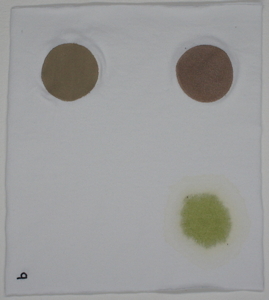 After: wash 01 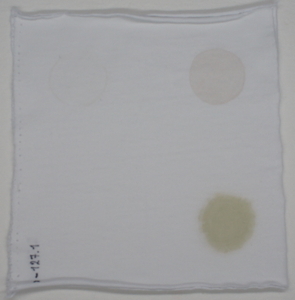 Before: wash 00 After: wash 01
|
Cleanliness
Perception. Stains Remotion Code: DINGY_TN/XX/ (specific for each stain or monitor) Specified intended use: to represent commercial stained worn (stained dingy) white garments, in which world�s consumers evaluate cleanliness in the garment context, by remotion of specific stained areas after first household washing/drying processes One (1) monitor contains one or several stained areas immersed in a dingy substrate that surrounds it This is a dingy test fabric with a localised stained area(s) that represents a stained worn garment ready to wash. Several relevant stains are applied manually at real concentrations levels onto shaded clean dingy fabrics DINGY_CL, wich is obtained previously after a total of ten (10) cycles of washing and drying. Surrounding dingy fabrics can follow different standard market realities (India, China, Latin America, Europe, USA or others) or customised specific realities according to client needs E. Environmental Soils Monitors
Each monitor dimension: ~20 cm X ~22 cm Selling
unit: per package of twenty five
(25) monitors Minimum order: one (1) package of twenty five (25) monitors
Regular price: US$ 21.7o /
monitor F. Food and Drink Soils Monitors F.1.
Combination of three (3) drink
soils and one (1) dingy context
in one monitor
Each monitor dimension: ~20 cm X ~22 cm Selling
unit: per package of twenty five
(25) monitors Minimum order: one (1) package of twenty five (25) monitors
Regular price: US$ 21.7o /
monitor F.2.
Combination of three (3) food
soils and one (1) dingy context
in one monitor
Each monitor dimension: ~20 cm X ~22 cm Selling
unit: per package of twenty five
(25) monitors Minimum order: one (1) package of twenty five (25) monitors
Regular price: US$ 21.7o /
monitor F.3.
Combination of three (3) food
soils and one (1) dingy context
in one monitor
Each monitor dimension: ~20 cm X ~22 cm Selling
unit: per package of twenty five
(25) monitors Minimum order: one (1) package of twenty five (25) monitors
Regular price: US$ 21.7o /
monitor Individual
Stains in Monitors (not for
collar&cuffs or armpit) Monitors with individual stains onto a dingy surrounding are produced on knitted cotton 100% or woven poly/cotton 65:35, clean dingy fabrics. Each monitor dimension of ~11 cm X ~12 cm Selling
unit: per package of fifty (50)
units of each stain Minimum order: one (1) package of fifty (50) units of each stain Regular
price: US$ 7.9o / unit Detergency data from these monitors can be processed-analysed-visualised using the web app Laundry-VR. More at: Laundry-VR link. |
|||||||||||||||||||||||||||||||||||||||||||||||||||||||
|
|
||||||||||||||||||||||||||||||||||||||||||||||||||||||||
Example: 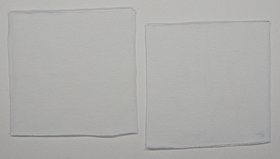 |
Olfactive
Cleanliness Perception.
Malodorous Control A unique way to measure consistently olfactive cleanliness under a consumer relevant olfactive context. Perception
of a garment's olfactive
cleanliness in real consumer
scenarios is considered one of
the primary elements that
impacts the purchase behaviour
of laundry products. That
perception results from the
complex and variable
interactions among fabrics,
odours, olfactive scenarios,
and consumers, which are often
chaotic. Environmental
Malodour Monitors:
Body
Malodour Monitors:
Food
Malodour Monitors:
These dingy standardised monitor are prepared on: Each monitor of 10 cm X 10 cm Selling unit: per package of twenty five (25) units Minimum order: one (1) package of twenty five (25) units Regular price: US$ 15.8o / unit
Malodour
Test Monitor - Brochure |
|||||||||||||||||||||||||||||||||||||||||||||||||||||||
|
|
||||||||||||||||||||||||||||||||||||||||||||||||||||||||
Example: 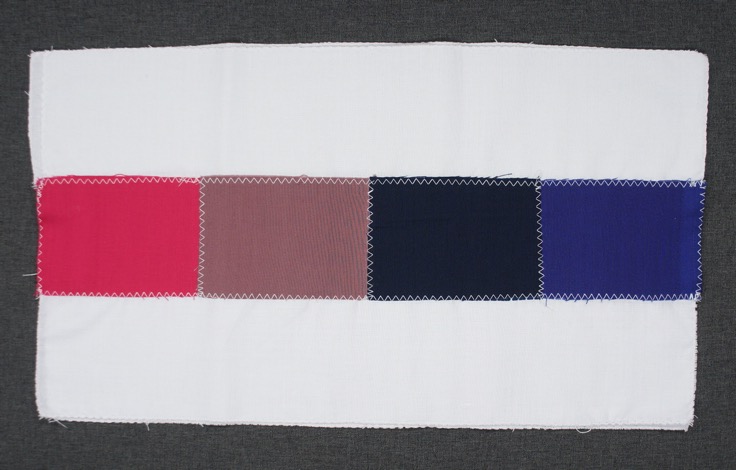 |
Colour
Care Perception. The
Coloured and Dingy White
Monitor Colour-care perception with simultaneous local contrast effects: Code: DINGY_CC/ Specified
intended use: to represent
commercial worn (clean dingy)
coloured garment that combines
white and colour areas, in
which world's consumers
evaluate colour-care benefits
of laundry products after
consecutive household
washing/drying processes One (1) monitor contains six (6) fabric swatches, four (4) coloured, one (1) original white and one (1) clean dingy white Current trend in the garment industry is the combination of colours and whites strips. One colour cloth is now the exception. This textile trend is a real challenge from the colour-care perspective, because now the problem is not only to preserve colours but also to preserve the whites areas, because if both are part of the visual scenario, there is full interaction between them. Detrimental changes in the whites areas will affect significantly the colour-care perception due to local contrast effects, colour will be perceived dull. This new dingy monitor from CONSUMERTEC offers for the first time a practical standardised alternative to technology innovators to experiment in the field of colour care in consumer relevant terms. Contrast effects or chromatic induction are very well know phenomenology in vision science but not implemented in the detergency industry, due to the regular use of basic colorimetric procedures. Algorithms to compute this visual effect needs a more complex approach. CLLS collection of algorithms coded by CONSUMERTEC offers this capability grounded on very recent advances in numerical models to represent more realistic interaction between white and colour in the same surface visual scenario. The monitor contains four (4) coloured swatches which are new original fabrics, commercial or standardised (AISE standards). Additionally it contains one (1) white swatch which is a new original fabric and another one (1) which is a clean dingy swatch, DINGY_CL, prepared according to relevant consumer realities, i.e. it represents a clean dingy white garment after ten (10) cycles of washing/drying cycles following different standard market realities (India, China, Latin America, Europe, USA or others) or customised specific realities according to client needs. This standardised monitor is prepared on cotton 100%. Each monitor of 22 cm X 40 cm. Selling unit: per package of twenty five (25) units Minimum order: one (1) package of twenty five (25) units Regular price: US$ 22.6o / unit Detergency data from these monitors can be processed-analysed-visualised using the web app Laundry-VR. More at: Laundry-VR link. |
|||||||||||||||||||||||||||||||||||||||||||||||||||||||
|
|
||||||||||||||||||||||||||||||||||||||||||||||||||||||||
Original coloured monitors (light grey on cotton, blue on cotton, light violet on poly/cotton and light blue on poly/cotton): 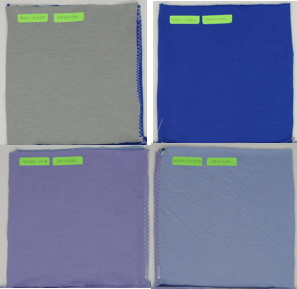 Abrasion process:  Aged monitors with fabric damage: 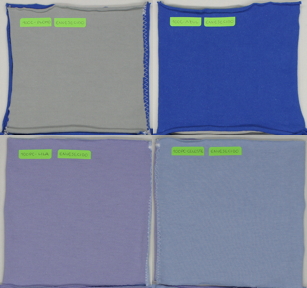 Monitors after a multi washing test: 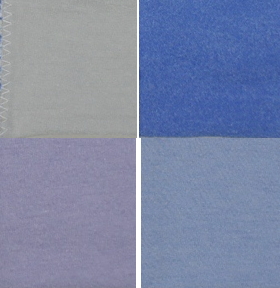 |
Colour
Restoration Perception. The
Dingy Aged Coloured Monitor
with Fabric Damage To measure fabric-care attributes of laundry products: Code: DINGY_CD/ Specified
intended use: to represent
commercial worn coloured
garment with fabric damage
after consecutive cycles of
washing/drying and abrasion,
in which world's consumers
evaluate fabric-care benefits
of laundry products after more
consecutive household
washing/drying processes One
(1) monitor contains four (4)
fabric coloured swatches, two
(2) original or new, two (2)
aged with fabric damage The majority of everyday coloured clothes are not new. They have become noticeably different to similar new garments after successive cycles of washing and drying after use. Some level of fabric damage appears, specially pilling in cotton and poly/cotton fabrics, which is formed due to rubbing or abrasion during normal wear: the �aged garment�. Some laundry technologies have shown the potential to both exacerbate the fabric damage or restore, in some level, the garment�s appearance. In line with this, CONSUMERTEC has developed these unique kind of test monitors by a combination of ten (10) cycles of washing/drying with soil ballast, and abrasion using robotics arms to rub fabrics in a full controlled way. Coloured aged monitors, original and aged, are offered to assist R&D efforts to verify/discover brand�s claims or to balance consumer benefits with technologies cost. It is recommended to use instrumental analysis to quantify changes on colour appearance and visual sensory analysis to quantify changes on pilling content. One unit of the monitor contains four (4) commercial swatches:
Selling unit: per package of twenty four (24) units. ninety six (96) total swatches: forty eight (48) original swatches and forty eight (48) aged swatches Minimum order: one (1) package of twenty four (24) units Regular price: US$ 20.5o / unit. US$ 492.oo / package Instrumental data (colour change) from these monitors can be processed-analysed-visualised using the web app Laundry-VR. More at: Laundry-VR link. |
|||||||||||||||||||||||||||||||||||||||||||||||||||||||
|
|
||||||||||||||||||||||||||||||||||||||||||||||||||||||||
Double Dingy Monitors: |
||||||||||||||||||||||||||||||||||||||||||||||||||||||||
|
Dingy collar&cuff:
Double dingy collar&cuffs: 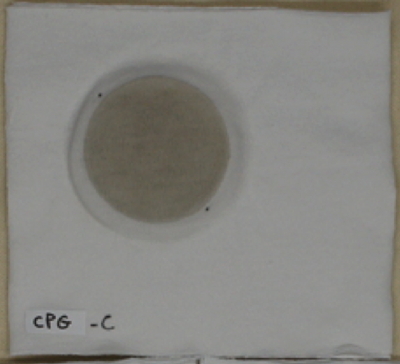
|
Collar and Cuffs Stained Monitor. Dingy and Double Dingy Code:
Dingy_TN/CP/ or D-Dingy_TN/CP/ Specified intended use: to represent commercial stained worn (stained dingy) white garment collars, in which world�s consumers evaluate cleanliness in the collar context, by remotion of the specific stained area after first household washing/drying processes Dingy version contains one (1) double-layered fabric swatch with two (2) areas: collar and cuff stained area immersed in a dingy substrate that surrounds it Double dingy version contains one (1) single-layered fabric swatch with two (2) areas: collar and cuff dingy stained area immersed in a dingy substrate that surrounds it Consumer cleanliness assessment of laundry product is not the same around the world, but it has been found that some washing problems are nearly the same despite different cultures and habits. Consistently, remotion of easily perceived stains present on white collar and cuffs constitute one of the icons linked to final consumer value delivered by laundry products. Unfortunately this simple cleanliness perception fact from the consumer point of view, is a very complex process from the R&D perspective, not only due to the complexity of the inorganic and organic constituents of the stain, but also due to the interaction of different fabric surroundings (the area in direct contact with the skin and the rest of the collar area) on final consumer cleanliness perception. CONSUMERTEC, using a custom-built non-contact mini spectrofluorimeter, has characterised the absolute spectrometric properties of very small fabric areas (less than 6 mm2), like the strip-shaped remanent collar and cuffs stained area after some process of wash, and its fabric surrounding, as well as accurate determination of typical fluorescence spectroscopy properties like: quantum absorptance function, quantum yield, and total, reflected and luminescent radiation coming from the fabric and capable to reach consumer's eyes. Our approach is a test fabric with a stained area on different dingy surroundings that simulate a worn white collar. with one area of fresh stain in case of dingy version or a dingy stain in case of double dingy version that mimic the combination of body and ambient soil, specifically a mixture of components of four groups: sweat gland secretions, sebaceous gland secretions, dead skin cells, and ambient particle and dust. The final monitor is obtained after a total of ten (10) washes and one (1) complex staining step. Surrounding dingy fabrics can follow different standard market realities (India, China, Latin America, Europe, USA or others) or customised specific realities according to client needs. 1. Dingy version:
2. Double dingy version:
Detergency data from these monitors can be processed-analysed-visualised using the web app Laundry-VR. More at: Laundry-VR link. |
|||||||||||||||||||||||||||||||||||||||||||||||||||||||
|
|
||||||||||||||||||||||||||||||||||||||||||||||||||||||||
|
Double dingy armpit on
poly/cotton: 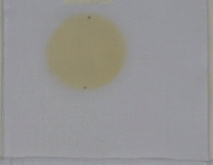
Double dingy armpit on cotton: 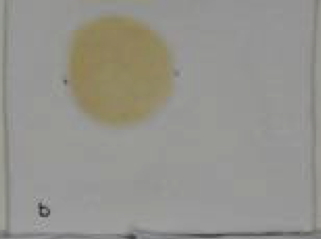
|
Armpit Stained Monitor. Double Dingy Code: D-DINGY_TN/AX/ Specified intended use: to represent commercial stained worn (stained dingy) white garment armpit area, in which world�s consumers evaluate cleanliness in that area context, by remotion of the specific stained area after first household washing/drying processes One (1) monitor contains one (1) fabric swatch with two (2) areas: armpit stained area immersed in a dingy substrate that surrounds it Probably is the second more problematic and common body stain in the consumer market and from the consumer point of view, a truly headache for the person in charge of laundry. From a technical point of view this is really complex stain that results from the interaction of deodorant product ingredients with underarm human secretions and proteinaceous residues, under oxidative conditions at certain temperatures, in a continuous cycles of wearing and washing. Our approach has been to model and simulate consumer realities in order to obtain a standardised stain with relevancy to different market scenarios.The visible stain is generated after three (3) cycles of staining and washing, onto a clean dingy fabric. The final monitor is obtained after a total of thirteen (13) washes. Relevancy depends on different commercial deodorants present in the market, and different surrounding fabric's dingy conditions, which in turn can follow different standard market realities (India, China, Latin America, Europe, USA or others) or customised specific realities according to client needs.
Detergency data from these monitors can be processed-analysed-visualised using the web app Laundry-VR. More at: Laundry-VR link. |
|||||||||||||||||||||||||||||||||||||||||||||||||||||||
|
|
||||||||||||||||||||||||||||||||||||||||||||||||||||||||
|
Double dingy menstrual fluid: 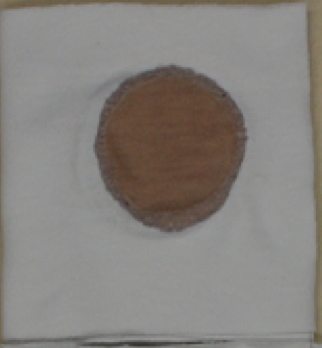
Double dingy socks: 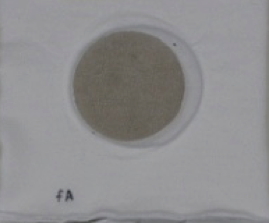 Double dingy urine-related: 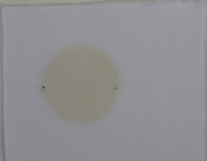 Double dingy pillow: 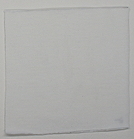 |
1.
Underwear Liner with
Menstrual Fluid. Double
Dingy Code: D-DINGY_TN/MF/ Combination
of blood and proteinaceous
material
2.
Socks. Double Dingy Code: D-DINGY_TN/SS/ Combination
of particle inorganic and
proteinaceous material
3.
Urine-related area. Double
Dingy Code: D-DINGY_TN/UR/ Combination
of electrolytes and organic
non-fluorescent and
fluorescent dyes
4.
Pillow. Double Dingy Code: D-DINGY_TN/PW/ Homogeneous
soiled area (not focal stained
area) by a combination of
fatty, inorganic and
proteinaceous material
Detergency data from these monitors can be processed-analysed-visualised using the web app Laundry-VR. More at: Laundry-VR link. |
|||||||||||||||||||||||||||||||||||||||||||||||||||||||
|
|
||||||||||||||||||||||||||||||||||||||||||||||||||||||||
Ready to order? or need assistance? .. please fill contact form here |
||||||||||||||||||||||||||||||||||||||||||||||||||||||||
| Quality
Control and Duration
In order to ensure quality, test fabrics are subject to an instrumental evaluation control when each batch of fabric is completed; it is done according to the amount of fabric, which is recorded on a control chart. Coefficient of variance of less than 5% is guaranteed. The fabric should be stored in a dark place and at low temperatures (approximately 5�C). It is also recommended that the package be opened only when tests are to be conducted. Under these conditions, the fabrics will have a six-month life expectancy. Basic Delivery Conditions
|
||||||||||||||||||||||||||||||||||||||||||||||||||||||||
|
|
||||||||||||||||||||||||||||||||||||||||||||||||||||||||
Home | Contact Us
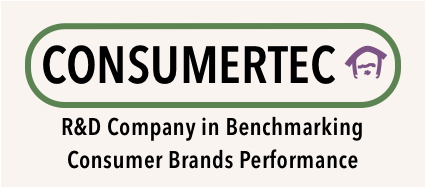

 Compared with conventional
non-consumer relevant technical
monitors, our dingy monitors are
fully washable in specific
domestic procedures in line with
what happens in the real market
to support total cleanliness
performance claims and to
balance formulations with a
consumer-centric approach.
Compared with conventional
non-consumer relevant technical
monitors, our dingy monitors are
fully washable in specific
domestic procedures in line with
what happens in the real market
to support total cleanliness
performance claims and to
balance formulations with a
consumer-centric approach.